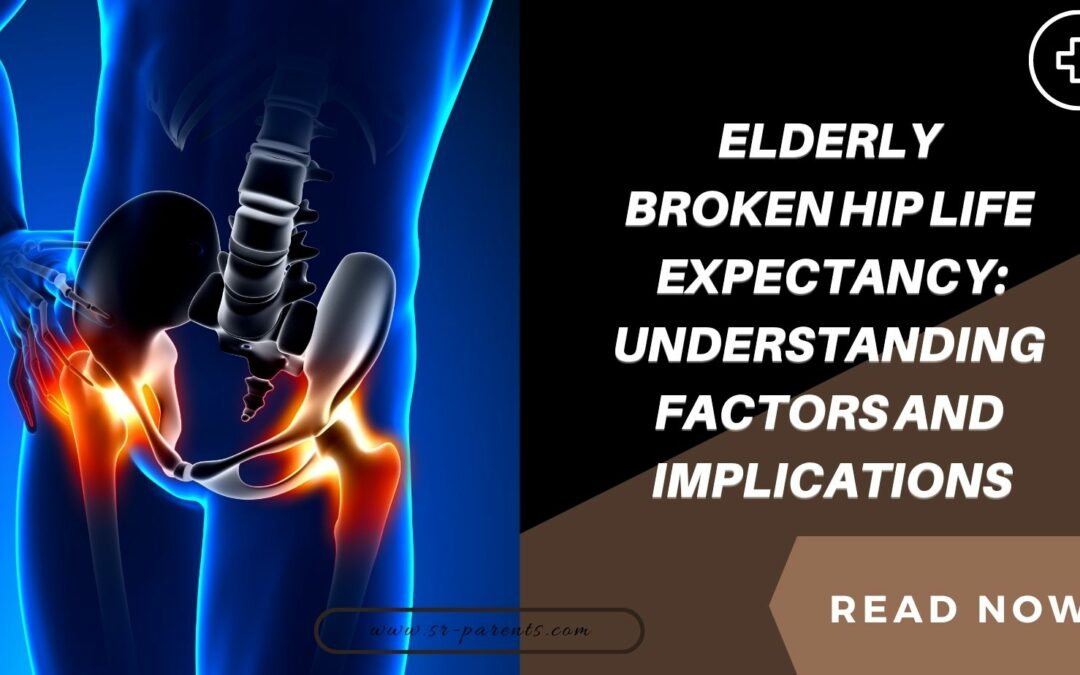A broken hip, also known as a hip fracture, is a severe injury commonly affecting older adults. It refers to a break in the upper part of the femur (thigh bone) near the hip joint. Hip fractures are associated with significant morbidity and mortality rates, making it crucial to understand the life expectancy of elderly patients with such fractures.

Estimating life expectancy is vital for several reasons. It helps healthcare professionals assess the prognosis and plan appropriate interventions for hip fracture patients. It provides crucial information for patients and their families regarding the potential impact on their quality of life and long-term outcomes. Understanding life expectancy can aid in identifying risk factors and developing strategies to improve survival rates and functional recovery.
This blog aims to share the life expectancies of elderly patients undergoing hip fracture surgery. By analyzing relevant data, we can gain insights into the factors influencing survival and provide valuable information for optimizing treatment strategies and improving outcomes for this vulnerable population.
Contents
Factors Affecting Life Expectancy
Several factors are crucial in determining the life expectancy of individuals who have experienced a hip fracture. Understanding these factors is essential for healthcare professionals to provide appropriate care and support to patients. This article explores the key elements influencing life expectancy following a hip fracture.

Age of the Patient
The patient’s age significantly determines life expectancy after a hip fracture. Elderly patients, particularly those over 65, face plays more significant challenges in recovering from such injuries. Studies have shown that hip fractures in older adults are associated with increased mortality rates, ranging from 8% to 38%. The aging body’s physiological changes and reduced resilience make it harder for older patients to endure the stresses of surgery, anesthesia, and rehabilitation.
Overall Health and Comorbidities
The overall health status and presence of comorbidities significantly impact life expectancy in hip fracture patients. Individuals with pre-existing conditions such as heart disease, cognitive impairment, or nutritional deficiencies tend to have shorter life expectancies after a hip fracture. These conditions can complicate surgical intervention and increase the risk of postoperative complications such as deep vein thrombosis or pulmonary embolism.
Type and Severity of the Hip Fracture
The type and severity of the hip fracture also influence life expectancy. Displaced fractures, particularly those involving the femoral neck, are associated with higher mortality rates than other types of hip fractures. The need for surgical treatment and the choice of surgical procedures can vary depending on the fracture type. For example, displaced femoral neck fractures often require surgical intervention, such as total hip replacement or other orthopedic procedures, which may pose additional risks to the patient.
Surgical Intervention and Post-operative Care
The choice of surgical intervention and the quality of post-operative care determine the life expectancy of hip fracture patients. Optimal treatment involves immediate surgery, as delayed interventions can lead to complications and increased mortality rates. The surgical procedures should be tailored to the patient’s needs and fracture characteristics. Close monitoring and management of postoperative complications, such as infection or deep vein thrombosis, are essential for improving outcomes and increasing life expectancy.
Rehabilitation and Recovery Process
After hip fracture surgery, insignificant integral crucial recovery is crucial to patients’ functional outcomes and life expectancy. Early mobilization and physical therapy are essential to critical recovery, as they help restore mobility, strength, and independence. A comprehensive rehabilitation program that addresses the patient’s needs and considers factors such as age, health status, and functional recovery goals can contribute to better long-term outcomes and improved quality of life.
Impact of a Broken Hip on Life Expectancy
A broken hip, also known as a hip fracture, can significantly impact an individual’s life expectancy. The following sections will explore the increased mortality risk immediately after the fracture and potential complications that can further affect life expectancy.
Increased Mortality Risk Immediately After the Fracture
Studies have shown that individuals who experience a hip fracture face a higher mortality risk in the immediate aftermath of the injury. Research indicates that the mortality rate for hip fracture patients within the first year ranges from 1 to 2 per 5 to 16 patients. This increased risk is particularly significant among elderly patients, with those 65 years and above being more susceptible. Hip fracture surgery is crucial in reducing mortality rates and improving outcomes for these patients. However, there are still risks associated with the surgical intervention itself.
Potential Complications and Their Impact on Life Expectancy
Several potential complications can arise following a hip fracture, and they can further impact life expectancy. The following subsections will discuss some common complications associated with hip fractures.

Infections
Infections are a performed risk factor for hip fracture patients. Surgical site infections, urinary tract infections, and pneumonia are among the most prevalent infections. These infections can lead to sepsis, a severe systemic infection that can be life-threatening, particularly for elderly patients. Early diagnosis, proper antibiotic treatment, and effective infection prevention measures are crucial in reducing the risk of infections and their impact on life expectancy.
Blood Clots
Deep vein thrombosis (DVT) and pulmonary embolism (PE) are significant concerns for patients with hip fractures. Reduced mobility, surgical procedures, and prolonged bed rest increase blood clot formation risk. If a clot travels to the lungs and causes a pulmonary embolism, it can be fatal. Prophylactic measures, such as blood thinning medications, compression stockings, and early mobilization, are essential in preventing these complications and minimizing their impact on life expectancy.
Pneumonia
Pneumonia is a respiratory infection due to immobility, reduced lung capacity, or aspiration. Elderly patients with hip fractures are particularly vulnerable to developing pneumonia due to compromised respiratory function and reduced mobility. Pneumonia can lead to severe respiratory complications and increase the risk of mortality. Early detection, prompt treatment, and respiratory care interventions can help minimize the impact of pneumonia on life expectancy.
Pressure Ulcers
Reduced mobility and prolonged bed rest can lead to pressure ulcers, also bedsores. These wounds can become severe, leading to infections and other complications. Elderly patients with hip fractures are at an increased risk of pressure ulcers due to their frailty and immobility. Implementing preventive measures, such as regular repositioning, proper wound care, and pressure-relieving surfaces, is crucial in minimizing the impact of pressure ulcers on life expectancy.
Decreased Mobility and Functional Decline
A hip fracture can significantly impair mobility and functional abilities. The loss of independence and decreased physical activity can contribute to a decline in overall health and quality of life. Functional recovery after a hip fracture can be challenging, especially among older adults. Rehabilitation programs and comprehensive geriatric care are essential in promoting mobility, restoring function, and improving overall outcomes. However, hip fracture surgery is performed immediately to note that some individuals may experience persistent mobility limitations, leading to a shorter life expectancy.
Strategies to Improve Life Expectancy
Hip fractures are a significant health concern among elderly patients, with mortality rates ranging from 8% to 38% within the first year following a hip fracture. To improve life expectancy in this population, several strategies can be employed.

Pre-operative Assessment and Optimization
Before hip fracture surgery, a thorough pre-operative assessment should be conducted. This assessment helps identify risk factors and comorbidities that may impact the patient’s outcome. Optimizing the patient’s health status through medical interventions, such as managing heart disease or cognitive impairment, can improve surgical outcomes and increase life expectancy.
Prompt Surgical Intervention and Proper Fracture Management
Timely surgical intervention is crucial for hip fracture patients. Delayed surgery can lead to complications and increased mortality. Therefore, it is essential to be essential with insignificant for 0 to 5 days of admission. Additionally, proper fracture management techniques, such as internal fixation or total hip replacement, should be employed based on the patient’s condition and fracture type to ensure optimal treatment outcomes.
Comprehensive Post-operative Care and Rehabilitation
Comprehensive post-operative care is vital in improving hip fracture patients’ life expectancy. This includes close monitoring for complications such as deep vein thrombosis or pulmonary embolism and prompt intervention if needed. Additionally, a structured rehabilitation program involving physical and occupational therapy should be implemented to promote functional recovery and improve quality of life.
Multidisciplinary Approach Involving Healthcare Professionals
A multidisciplinary approach involving healthcare professionals from various specialties is essential for optimizing outcomes in geriatric hip fracture patients. Orthopedic surgeons, geriatricians, anesthesiologists, nurses, and physiotherapists should collaborate to provide comprehensive and coordinated care throughout the patient’s journey, from pre-operative assessment to post-operative rehabilitation.
Fall Prevention Measures and Lifestyle Modifications
Implementing fall prevention measures and encouraging lifestyle modifications are crucial to reduce the risk of future hip fractures and improve life expectancy. This includes ensuring a safe environment, addressing factors contributing to falls (such as poor lighting or loose rugs), and promoting physical activity and strength training to improve balance and muscle strength.
Management of Comorbidities and Chronic Conditions
Hip fracture patients often have multiple comorbidities and chronic conditions that can impact their life expectancy. Proper management of these conditions, such as optimizing heart failure treatment or addressing nutritional status, is important for improving outcomes and prolonging life expectancy.
Prognostic Indicators for Patients with Hip Fractures
Hip fractures, mainly displaced femoral neck fractures, pose significant challenges for healthcare providers due to their high mortality rates. Assessing prognostic indicators is crucial to predict outcomes accurately and ensure optimal patient treatment. This article explores scoring systems, cognitive function assessment, social support, and community resources as critical factors in predicting patient outcomes.
Scoring Systems and Tools to Predict Outcomes
Various scoring systems and tools have been developed to assess the prognosis of patients with hip fractures. These tools consider age, gender, comorbidities, fracture type, and functional status. They provide valuable insights into mortality rates, functional recovery, and the likelihood of complications liideo Creditske deep vein thrombosis and pulmonary embolism. By utilizing these tools, healthcare professionals can identify high-risk patients and tailor their treatment plans accordingly.
Importance of Assessing Cognitive Function and Mental Health
Cognitive impairment is prevalent among elderly patients with hip fractures and is associated with increased mortality rates. Assessing cognitive function and mental health is crucial to determine the patient’s ability to follow treatment plans, understand post-operative instructions, and engage in rehabilitation programs. By considering these factors, healthcare providers can optimize care strategies and offer appropriate support to enhance patient outcomes.
Role of Social Support and Community Resources
Social support and access to community resources significantly impact the recovery and well-being of patients with hip fractures. Adequate support networks can enhance post-operative care, rehabilitation adherence, and overall functional outcomes. Community resources such as physical therapy, transportation assistance, and home care services play a vital role in facilitating recovery and improving the quality of life for patients.
This video contains a visual explanation of the causes of hip fractures, aimed at helping students of medicine and healthcare professionals prepare for exams.
Video Credit: @ZeroToFinals
Addressing Underlying Health Issues and Advancing Treatment for Patients with Hip Fractures
In hip fracture treatment, it is imperative to recognize the importance of addressing underlying health issues and promoting overall well-being. Research on patients with hip fractures, particularly those aged 65 years and above, has shown increased mortality rates following such fractures. It is crucial to consider factors like gender differences, cognitive impairment, and heart disease, which can significantly impact outcomes.

Future directions for research should focus on optimal treatment strategies and identifying independent predictors of functional outcomes. Additionally, advancements in surgical techniques and joint replacement procedures can enhance patient outcomes and quality of life. Collaboration between medical research councils, national health authorities, and healthcare providers can lead to standardized protocols and improved patient care.
By addressing underlying health issues, conducting further research, and advancing treatment approaches, we can reduce mortality rates and enhance functional recovery for patients with hip fractures.
Frequently Asked Questions
What is the life expectancy for patients with a hip fracture?
The mortality rate following a hip fracture ranges from 3 to 8 times higher than the general population. Female patients have a higher risk, with mortality rates ranging from 4 to 16 times higher. Fracture patients face increased mortality, especially those with displaced femoral neck fractures.
Are there any factors that affect life expectancy in these patients?
Several factors influence life expectancy in elderly patients with hip fractures. Age is a significant factor, with patients 65 and above facing higher mortality. Other factors include cognitive impairment, heart disease, deep vein thrombosis, and pulmonary embolism.
Does surgical treatment improve life expectancy?
Surgical intervention is crucial in improving outcomes for hip fracture patients. Different surgical procedures, such as joint replacement, can improve functional recovery and increase survival rates.
Is there an optimal treatment approach for hip fracture patients?
Optimal treatment depends on individual patient characteristics and health status. However, surgical treatment is generally recommended for elderly patients with hip fractures as it has been shown to improve outcomes and reduce mortality rates.
Can gender differences impact life expectancy?
Female patients have higher mortality rates following a hip fracture than male patients. This gender difference should consider when assessing prognosis and planning treatment.
What are the functional outcomes for elderly patients with hip fractures?
Functional recovery is an essential aspect of treatment. Achieving optimal functional outcomes is integral when managing hip fractures in elderly patients.
Are there any independent predictors of life expectancy in these patients?
Several factors, including age, cognitive impairment, heart failure, and fracture type, have been identified as independent predictors of life expectancy in elderly patients with hip fractures.
Do national health guidelines address the treatment of hip fractures in older people?
National health guidelines, such as those in the European Economic Area, provide recommendations and standards for treating hip fractures in elderly patients. These guidelines aim to ensure consistent and high-quality care for all individuals.
Discover Expert Tips for Elderly Hip Fracture Care Today!
Want to stay informed about the latest tips and information regarding the care of elderly patients with hip fractures? Look no further! Follow Senior Parents on our social media channels to access valuable insights, expert advice, and practical tips to ensure the best possible outcomes for your loved ones.
From understanding the impact of hip fractures on life expectancy to exploring surgical interventions and functional recovery, our social media platforms are the go-to resources for comprehensive knowledge. Join our community and be part of the conversation. Click on the links below to connect with us:
- Facebook: https://www.facebook.com/sr.parents
- Instagram: https://www.instagram.com/seniorparents/
- Pinterest: https://www.pinterest.com/seniorparents/
- Twitter: https://twitter.com/senior_parents






